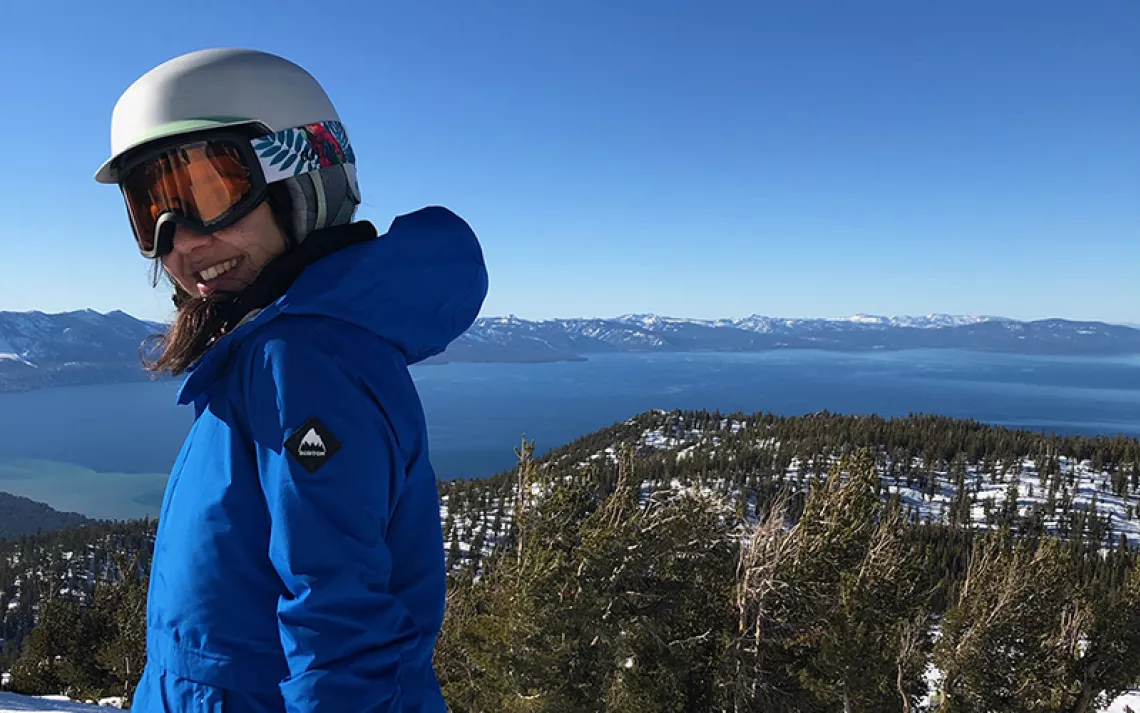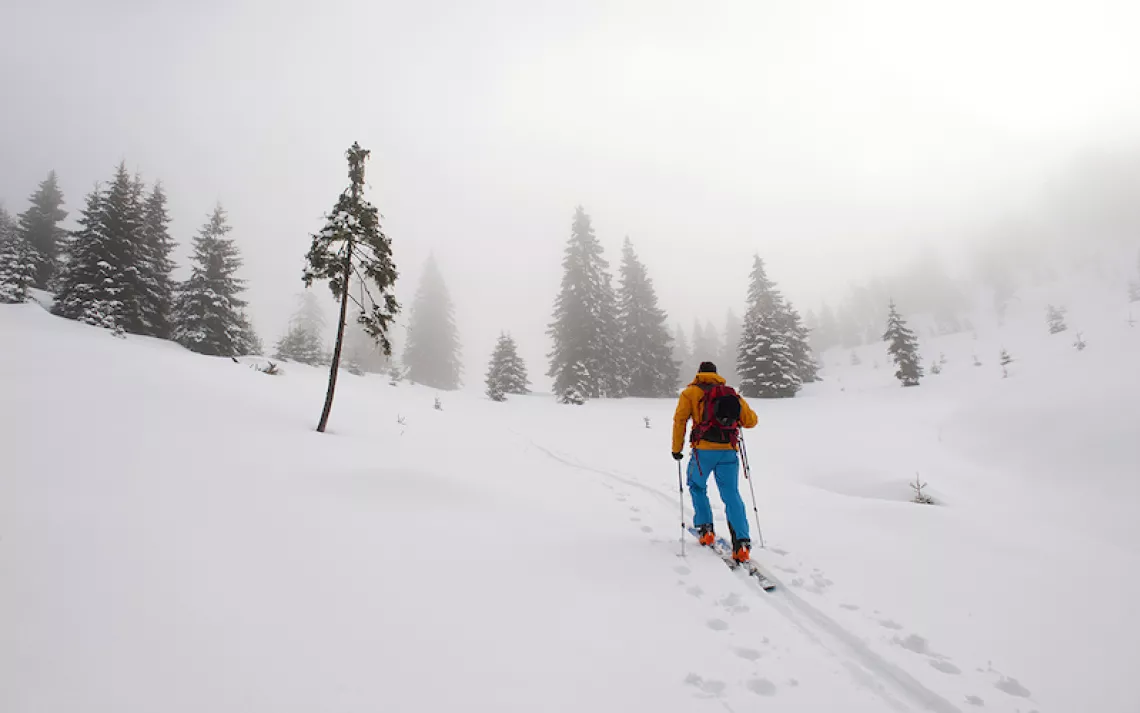How to Earn Your Turns on Backcountry Skis
Welcome to the most environmentally friendly way to embrace winter

Photos by Conor Mihell
Backcountry skiing is one of the purest outdoor activities I know of. That may sound like a myopic statement, considering the fact that ski resorts and the travel industry in general hardly boast pristine carbon footprints. While many alpine and Nordic ski destinations are currently waging existential battle, via investments in renewable energy and aspirations of carbon neutrality, skiing remains its own worst enemy in contributing to a feedback loop that’s rapidly making winter an endangered season around the world.
But backcountry skiing doesn’t require infrastructure or long-distance air travel. I live in the heart of the Great Lakes, and I’m lucky to be able to access snowy public lands almost right out my door; I step into my backcountry skis and kick and glide (or plod, depending on the snow conditions) into Canadian Shield Hills—for free. I push through knee-deep snow, switchbacking through hardwood forests to the rounded summits of ancient mountains. Bald rocks offer glimpses of squalls moving in off Lake Superior. The climbing is hard work. Which makes the views—and the feeling of soaring downhill through the powder—that much sweeter. And if you happen to live in or near the Rockies, in the Midwest, or in Appalachia (among many other places), you too can savor this guilt-free wintry pleasure. Here’s how to maximally enjoy yourself while minimally impacting your surroundings.

Wherever there's snow
You don’t need epic mountains or bottomless powder to go backcountry skiing. The requirements are simple: snow and open space. A golf course will do, as will a farm field or urban park. Rolling terrain offers novices the chance to experience short climbs and easy downhills, without the risk of avalanches. If you insist on skiing at a resort, do your homework and choose one that participates in the National Ski Area Association’s climate challenge. Better yet, go multiday backcountry skiing through Colorado’s 10th Mountain Division Huts or Vermont’s Catamount Trail. (Be sure to invest in carbon offset credits if you travel by air to your destination. Also note that the Turo car-sharing network rents electric vehicles.)
Get the gear
The skis, bindings, and boots you choose for backcountry skiing all depend on where you’ll ski. On mellow terrains, such as farm fields and golf courses, you can get away with the same cross-country skis, lightweight boots, and bindings you’d use for skiing groomed tracks. Wider skis, preferably with metal edges for better grip while traversing, along with beefier NNN-BC or three-pin bindings and stiffer boots, are best for skiing on mixed terrain where touring is your primary goal. This is my primary mode of skiing, and I use a pair of Fischer S-Bound skis with Voile three-pin bindings and a timeless pair of Alico leather telemark boots, which I purchased for $20 at a local ski swap.
You’ll want fatter, alpine-style skis if your goal is to ski steep, powder slopes. Any downhill ski will do, as long as it’s mounted with an alpine touring (AT) or telemark binding, both of which allow you to release your heel for uphill skiing. The made-in-Utah Voile UltraVector BC is a good option for backcountry powder; the company also makes telemark bindings, and Scarpa is a veteran manufacturer of aggressive telemark boots. Telemark is favored by skiing traditionalists for its graceful turns. AT, on the other hand, is an easier transition for experienced downhill skiers; you’ll find a variety of Dynafit AT bindings and boots. The length of ski you choose is also determined by the type of skiing you wish to do, with general lengths decreasing from around 185 to 205 cm for cross-country skis to under 185 cm for backcountry downhill.
Whatever your terrain, skis with a waxless base (seek out a fishscale-pattern, such as the Fischer and Voile skis listed above) offer good grip in varied snow conditions and the versatility of being able to switch from climbing to downhill instantly. Climbing skins—essentially self-adhesive carpet for your skis—make for easier climbing in steep, mountainous areas (though they must be removed once you’re headed downhill). Choose a pair of poles with large baskets for better purchase in soft snow. Adjustable poles such as the Black Diamond Traverse allow you to adapt the length for touring (longer) and skiing downhill (shorter). The price of brand-new backcountry ski equipment is intimidating, but you can often score used equipment for a fraction of retail.
Basic techniques
Backcountry skiing is the same as Nordic skiing in ungroomed snow. Regardless of the equipment you use, you’ll employ the same diagonal stride (kick and glide) motion that’s used by classic cross-country skiers on groomed tracks. The mechanics are similar to jogging: Step down with the ball of your foot to engage your ski’s waxless pattern (or climbing skin) to push off, and glide on the other ski; and alternately plant your poles for added push the same way you swing your arms while walking.
You’ll quickly discover the limits to your equipment when skiing uphill. Use the same diagonal stride motion, emphasizing the step down (stomp) part and shortening your stride. If you feel yourself sliding backward, adjust your angle to a more modest slope. Use a zig-zag pattern to ascend longer grades with a series of switchbacks. Climbing skins allow you to climb far steeper grades with fewer switchbacks.
Downhill skiing in powder on telemark or AT skis is an art unto itself and best learned with an instructor. On modest terrain with skinnier skis and lighter bindings, you can control your descent by performing long traverses down the slope, favoring uphill turns to check your speed.
Spend the night
Backcountry skis are the ultimate vehicle to increase your range for a winter camping adventure. Our introductory tips for winter camping are easily transferred to skiers, with some good advice for dressing for cold weather too.
Leave no trace
In many ways, it’s easy to minimize your impacts while backcountry skiing: Our tracks in the snow will inevitably be filled in or melt away. However, winter makes it more difficult (and sometimes uncomfortable) to deal with human waste. Frozen ground dictates the best practice of burying human waste in shallow snow, well away from waterways; freeze-and-thaw cycles and exposure to the sun will kill pathogens. Toilet paper should be packed out; or better yet, use snow wipes. It’s wonderful to encounter wildlife, but remember that winter tests their endurance—so keep interactions to a minimum and observe from afar.
Stay safe
Backcountry skiers’ favored slopes are also most likely to avalanche, and in many locations, climate change is enhancing the risk of slides. Take an avalanche safety course from the American Institute for Avalanche Research and Education or the American Avalanche Institute before venturing into alpine areas, and be mindful of local avalanche forecasts.
 The Magazine of The Sierra Club
The Magazine of The Sierra Club



